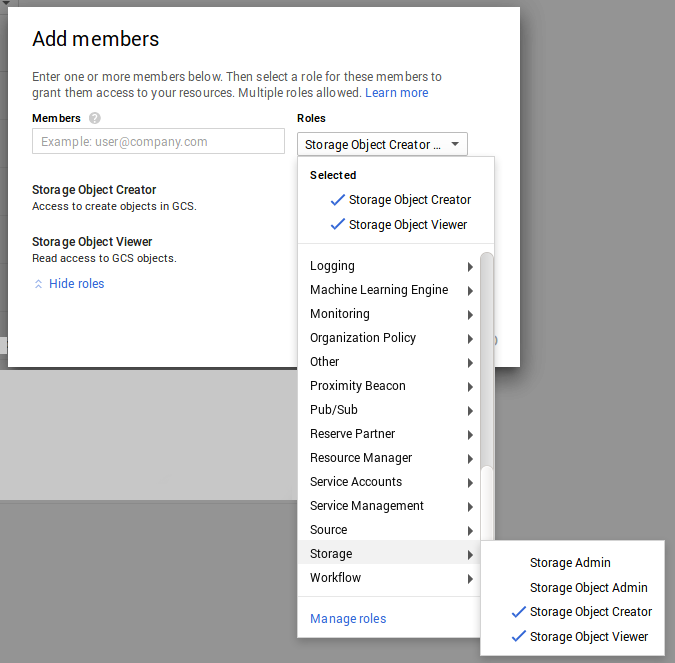Generate Google Gs_access_key_id
Backup to Google Cloud Storage using duplicity 0.6.22
- Generate Google Gs_access_key_id Download
- Generate Google Gs_access_key_id Email
- Generate Google Gs_access_key_id Chrome
- Generate Google Gs_access_key_id Page
Sep 29, 2016 To generate a boto file that uses p12 credentials, you can run gcloud config set passcredentialstogsutil false, then run gsutil config -e, followed by gcloud config set passcredentialstogsutil true to make gcloud's auth magic work normally again. Gsaccesskeyid and gssecretaccesskey can be generated by navigating to your Google Cloud Storage console and clicking on Settings. On the Settings page, navigate to the Interoperability tab and click Enable interoperability access. On this page you can now click Create a new key to generate an access. Run gsutil config -a to generate a /.boto configuration file with your key info. Alternatively (or if you don’t use gsutil) you can set the GSACCESSKEYID and GSSECRETACCESSKEY environment variables. Backup using a gs:// URL.

My patch to add support to duplicity for Google Cloud Storage was merged and released with duplicity version 0.6.22. Now backing up to GCS is as easy as backing up to S3. Here are the steps:
Gsaccesskeyid and gssecretaccesskey can be generated by navigating to your Google Cloud Storage console and clicking on APIs & services/Credentials.On this page you can now click Create credentials/OAuth client ID to generate an access key and a matching secret. Mar 17, 2020 Create bucket using Google Cloud Console and set appropriate permissions. STATICBUCKETNAME: Name of the bucket to collect static files (mandatory if COLLECTSTATICFILESONSTORAGE is set to true) GSACCESSKEYID: Google Cloud Access Key. GSSECRETACCESSKEY: Google Cloud Secret Access Key. How to create Access Keys on Google.
Monster hunter generations hunter rank 3 key quests 2017. I still remember the first time my cousins saw the docking manuever while playing the Japanese version of the game. 'Wait, did they just combine?
- Install duplicity >= 0.6.22.
- Enable Interoperable Access in the Cloud Storage Dashboard.
- Generate Interoperable Storage Access Keys in the Cloud Storage Dashboard.
- Create your bucket:
The
-c DRAflag enables Durable Reduced Availability for this bucket, which makes sense for backups. - Run
gsutil config -ato generate a~/.botoconfiguration file with your key info. Alternatively (or if you don’t use gsutil) you can set theGS_ACCESS_KEY_IDandGS_SECRET_ACCESS_KEYenvironment variables. - Backup using a
gs://URL. For example:

- Examples
- This module allows users to manage their objects/buckets in Google Cloud Storage. It allows upload and download operations and can set some canned permissions. It also allows retrieval of URLs for objects for use in playbooks, and retrieval of string contents of objects. This module requires setting the default project in GCS prior to playbook usage. See https://developers.google.com/storage/docs/reference/v1/apiversion1 for information about setting the default project.
| parameter | required | default | choices | comments |
|---|---|---|---|---|
| bucket | yes | Bucket name. | ||
| dest | no | The destination file path when downloading an object/key with a GET operation. | ||
| expiration | no | Time limit (in seconds) for the URL generated and returned by GCA when performing a mode=put or mode=get_url operation. This url is only available when public-read is the acl for the object. | ||
| force | no | True | Forces an overwrite either locally on the filesystem or remotely with the object/key. Used with PUT and GET operations. aliases: overwrite | |
| gs_access_key | yes | GS access key. If not set then the value of the GS_ACCESS_KEY_ID environment variable is used. | ||
| gs_secret_key | yes | GS secret key. If not set then the value of the GS_SECRET_ACCESS_KEY environment variable is used. | ||
| headers | no | {} | Headers to attach to object. | |
| mode | yes |
| Switches the module behaviour between upload, download, get_url (return download url) , get_str (download object as string), create (bucket) and delete (bucket). | |
| object | no | Keyname of the object inside the bucket. Can be also be used to create 'virtual directories' (see examples). | ||
| permission | no | private | This option let's the user set the canned permissions on the object/bucket that are created. The permissions that can be set are 'private', 'public-read', 'authenticated-read'. | |
| src | no | The source file path when performing a PUT operation. |
Generate Google Gs_access_key_id Download
Generate Google Gs_access_key_id Email
This module is flagged as preview which means that it is not guaranteed to have a backwards compatible interface.
This module is community maintained without core committer oversight.
Generate Google Gs_access_key_id Chrome
For more information on what this means please read Module Support
Generate Google Gs_access_key_id Page
For help in developing on modules, should you be so inclined, please read Community Information & Contributing, Helping Testing PRs and Developing Modules.